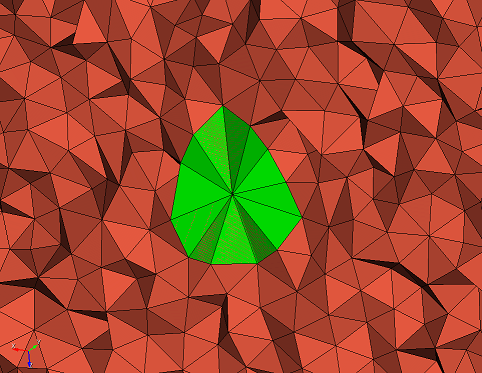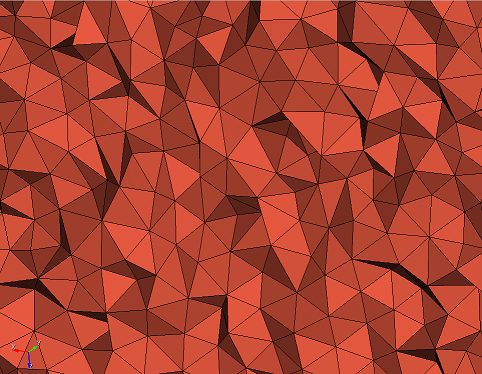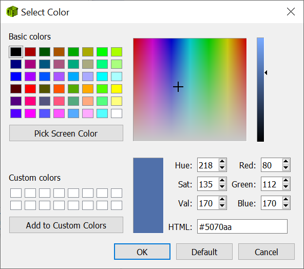- Product Description
- Product Highlights
- Contact Information
- New Features
- Defects Fixed
- Documentation
- Contents of Release
- Platforms Supported
Product Description
Product Highlights
For more information on CUBIT™, including licensing arrangements and terms see the CUBIT™ website.
New Features in CUBIT™ 16.08
Index of New Features
Meshing
Remesh tet with sizing option
When remeshing a set of tets, a size option is now available to control the sizes of the generated tets. The new options for this command is shown here:
Remesh tet <id_range> ... [inflate <value>] **[size <size>]** [FIXED|free] [preview]
The following images illustrate a situation where localized tets may have a larger size than desired and remeshing with a size parameter will help reduce the element size to the desired size.


For more information see: Remeshing
Geometry
Automatic Reduction of Thin Volumes
With the new thin volume automatic reduction functionality, 3D volumes can be automatically reduced for shell modeling while maintaining a contiguous 2D connected set of sheet bodies. Blocks are automatically created and attributed with a computed thickness and loft factor. Additional commands allow for visual inspection of the reduction and exporting a csv file containing reduction details for input deck creation.
Reduce {Volume } Thin Auto [Sort] [Preview]
For more information see: Reduce Thin Volumes

New support for SGM with geometry classification
When importing a model into SGM, machine learning based classification is now available. Both identification of categories and training of categories is available. For example, if a model containing bolts is loaded into SGM, one can use the following command syntax to identify bolts:
list volume with category "bolt" ids
For more information about SGM see: Importing SMG Files
Miscellaneous
Cubit RGB Colors
The color specification in CUBIT has been enhanced to allow for RGB and RGBA color specification in any command. This is an addition to being able to use color names and ids. The color choosing dialog in the graphical user interface has been enhanced to support choosing any RGB color.

The syntax of these new color specifications is:
rgb <r> <g> <b>rgba <r> <g> <b> <a>
Accepted values range between 0.0 and 1.0. An example of using this is:
color volume 1 rgb 0.5 0.3 0.9
Using the RGBA specification can be useful when making individual surfaces transparent. The alpha value can range between 0.0 and 1.0 where 1.0 is opaque and 0.0 is transparent/invisible. To make a surface transparent, issue the command:
color surface 1 rgba 0.5 0.3 0.9 0.3
Improved Model Tree Performance
CUBIT™’s user interface model tree was slowing down some of the commands. The tree has been refactored to improve performance. The model information is now copied fewer times. The relationships between the tree items has been streamlined as well.
The tree’s overhead was cut in half when creating and merging volumes. In one user’s case of renumbering nodesets, the tree’s overhead was cut down to a tenth.
CUBIT™’s Python Interface Enhancements
- get_solutions_for_thin_volume – Parameters updated for feature improvement
- get_solutions_for_sheet_volume_connection – Parameters updated
- get_2D_sheet_volumes – Get sheets associated with a thin volume
- get_3D_thin_volume – Get the thin volume associated with a sheet
The folowing methods have been updated to handle more than just volumes:
- get_ML_classification
- get_ML_classifications
- get_ML_classification_categories
- ML_train
Defects Fixed in CUBIT™ 16.08
| Ref# | Description |
| MESH-4520 | [Capablity-Hex Meshing] Sweeping in Cubit when there are holes |
| MESH-6533 | User Support: Mesh files not closed by lite import? |
| MESH-6654 | Cubit Training |
| MESH-6711 | seg fault when opening a interactive window in cubit python |
| MESH-6739 | Heal multiple stl files using SGM |
| MESH-6737 | Export File > sierra – fix interaction block |
| MESH-6710 | Python script seg faults |
| MESH-6697 | Error list with large number of composites |
| MESH-6696 | GUI split curve location bug |
| MESH-6574 | Id sorting in tree alphabetically |
| MESH-6573 | Compositing slowed down by model tree? |
| MESH-6450 | Slowdown in GUI when renumbering sidesets |
| MESH-6340 | RGB color in CUBIT |
| MESH-3934 | Adjust printing of current entity selected in Cubit |
Documentation Updates
The CUBIT™ 16.06 online documentation may be found here. A PDF version is also available for download. The CUBIT™ GUI installation also includes the full user documentation included with the program. The user’s manual may be accessed from the Help menu.
CUBIT™ 16.08 Contents of Release
CUBIT™ Program: The installation package includes executables and libraries, packaged in tar.gz files for Linux machines. For Windows, the package is in a self-installing executable, and for Mac OS X a .dmg file is provided. Both a command line and GUI version of CUBIT™ are included with the installation package for all platforms.
Documentation: Linux, Windows and Mac versions include full online documentation.
Platforms Supported
CUBIT™ 16.08 supports the following Platforms:
- Linux RedHat Enterprise 7 and 8
- Windows 10
- macOS 10.14+
Non-Sandia Users
CUBIT™ is freely available for United States government use. For more information on licensing CUBIT™, including academic, commercial, and all other use, go to our licensing page. For current CUBIT™ users, CUBIT™ 16.08 may be downloaded from the CUBIT™ download page.
Sandia Personnel Only
CUBIT™ 16.08 may be downloaded from the CUBIT™ download page.
Windows
Download a Windows installation file and double-click to install.
MAC OS X
Download a Mac OS X disk image file. After the disk image is opened, click and drag the CUBIT™ folder to /Applications.
LINUX LANS
Check with your local LAN administrator for instructions on how to access CUBIT™ on your local LAN. In most cases typing one of the following commands at the UNIX prompt should allow you to execute CUBIT™. In some cases, the full path will need to be specified:
/projects/cubit/<cubit_command>
| cubit | The latest released version (16.08) of CUBIT™ deployed to the LAN. |
| cubit -nogui | The latest released version (16.08) with just the Command Line and graphics window |
| cubit -nogui -nographics | The latest released version (16.08) with just the Command Line |
| cubit-16.08 | Version 16.08 with GUI |
| cubit-beta | The latest beta version still in development |
Contact Information
CUBIT™ Help
For general technical questions including download, installation and CUBIT™ technical assistance.
CUBIT™ Licensing and Passwords
Email: asc-approvals@sandia.gov
CUBIT™ Support Lead
Trevor Hensley
Phone: 505-284-7756
Email: cubit-help@sandia.gov
CUBIT™ Project Lead
Roshan Quadros
Sandia National Laboratories
Computational Simulation Infrastructure (org. 1543)
Phone: 505-220-9458
Email: wrquadr@sandia.gov